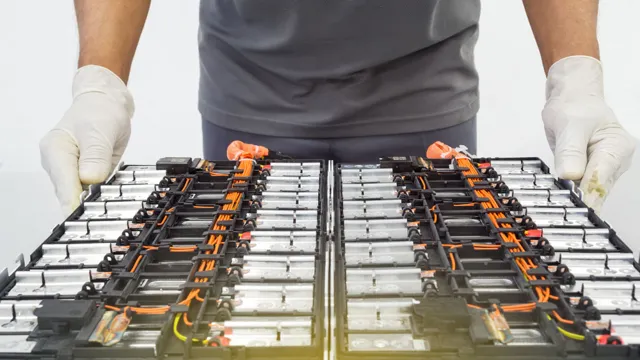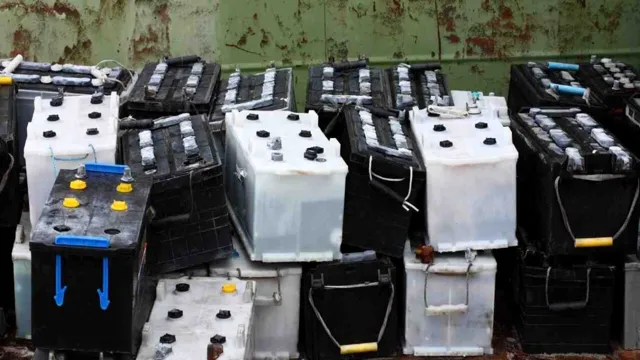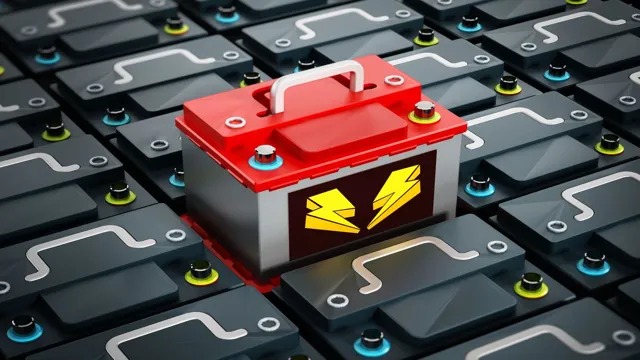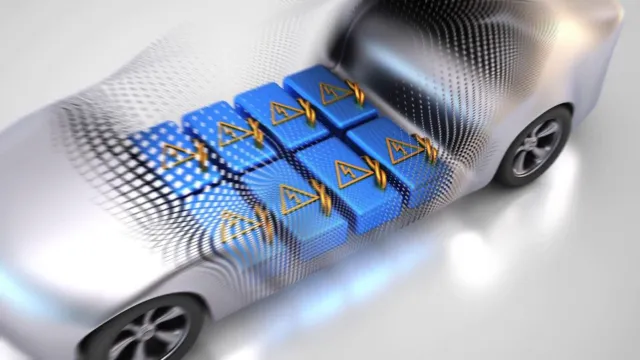Eco-Friendly Innovation: The Fascinating Cycle of Creating and Disposing Electric Car Batteries
Electric cars have become an increasingly popular choice for eco-conscious individuals seeking to reduce their carbon footprint. However, as with any new technology, there are questions surrounding the sustainability and longevity of electric car batteries. How long do they last? What happens to them after they reach the end of their useful life? These are valid concerns that demand answers.
The cycle of an electric car battery begins with the manufacturing process, where the necessary materials are extracted, refined, and assembled. Once complete, the battery is installed in the car and begins powering its electric motor. Over time, the battery starts to degrade, with its ability to hold a charge diminishing bit by bit until it becomes no longer useful in the car.
At this point, many people wonder what happens to the battery. Is it just thrown away? In fact, most electric car batteries can be recycled, allowing their valuable metals to be extracted and reused in new batteries. This is an important process that helps to reduce the environmental impact of electric cars even further.
However, the exact lifecycle of an electric car battery can vary depending on a number of factors, including how frequently the battery is charged and discharged, as well as the type of technology used in the battery itself. If you’re considering an electric car, it’s important to do your research and understand how to care for your battery to ensure the longest possible lifespan. In conclusion, electric car batteries offer a promising alternative to traditional combustion engines, but it’s important to understand their lifecycle and the steps we can take to ensure their continued sustainability.
By properly caring for and recycling electric car batteries, we can minimize their environmental impact and help build a cleaner, greener future for all.
Overview
The creation and disposal of electric car batteries is a crucial aspect of the electric vehicle industry. While these batteries are essential for powering electric cars, they also pose environmental challenges when it comes to disposal. The manufacturing process of creating these batteries is complex and includes mining and refining of raw materials, manufacturing of battery components, and assembling the battery itself.
The disposal process can also be complex, as these batteries contain hazardous materials that need to be dealt with carefully. Fortunately, efforts are being made to find new ways to recycle and reuse these batteries. The shift towards sustainable practices is already evident, with the rise of green energy sources and recycling initiatives that could help minimize the environmental impact of these batteries.
Ultimately, the success of the electric vehicle industry depends on finding sustainable solutions for the creation and disposal of electric car batteries.
The Creation Process
The creation process is a crucial aspect of any project or product development, and it involves a series of steps that help bring an idea to fruition. This process usually begins with an idea or concept that needs to be fleshed out into a tangible product or service. The first step involves brainstorming and researching to gain insights on what other similar products exist in the market, how the idea can be improved or made different, and how it can best meet the needs of the intended audience.
The next step involves creating a prototype or a minimum viable product that can be tested and refined based on user feedback. Once the product is finalized, it can then be produced, marketed, and launched into the market. This process requires collaboration among team members, constant iteration and improvement, and effective communication to ensure that the end product meets the requirements and goals of the project.
By following these steps, the creation process can be successful in delivering a high-quality product that meets the needs of consumers.

Key Components
When it comes to creating a successful blog, there are a few key components that must be included. First and foremost, having high-quality, relevant content is crucial for attracting and retaining readers. This means researching and choosing topics that your target audience is interested in and presenting them in a clear, concise manner.
Additionally, incorporating search engine optimization (SEO) techniques such as using relevant keywords, meta descriptions, and internal linking can help increase your blog’s visibility and reach. Another important factor is providing a visually appealing and user-friendly design for your blog, which includes easy navigation and mobile responsiveness. Finally, engaging with your readers and building a community around your blog through social media and email marketing can foster lasting relationships and help grow your audience.
By incorporating these key components into your blog, you can create a successful and thriving online presence. So, what are you waiting for? Start creating and sharing your unique content today!
The Disposal Process
When it comes to disposing of waste, it is important to have an effective and thorough process in place. This involves properly sorting and separating different types of waste, as well as ensuring that hazardous waste is handled and disposed of safely. In general, the disposal process begins with the identification and segregation of different types of waste, followed by appropriate storage and transportation to a disposal facility.
At the disposal facility, waste may be treated, incinerated, or buried, depending on the type of waste and its potential impacts on the environment. Overall, the disposal process plays a critical role in ensuring that waste is handled in a safe and responsible manner, minimizing any negative impacts on the environment and human health.
Environmental Impact
The creation and disposal of electric car batteries have been hot topics in conversations about the environmental impact of electric vehicles. While EVs are viewed as a cleaner alternative to traditional gas-powered cars because they emit zero emissions while driving, the same cannot be said for the production and disposal of their batteries. The production of electric car batteries requires a significant amount of energy and resources, including materials that are often mined in environmentally sensitive areas.
Once the battery reaches the end of its life, it must be disposed of properly to prevent it from releasing toxic chemicals into the environment. Despite these challenges, the growing demand for electric cars is driving technology advances that aim to minimize the environmental impact of EV batteries, including recycling and repurposing initiatives. Overall, while there are challenges with the creation and disposal of electric car batteries, it is clear that EVs are still a better choice for the environment than traditional gas-powered cars in the long run.
Greenhouse Gas Emissions
Greenhouse gas emissions have a significant impact on the environment. Carbon dioxide (CO2), methane (CH4), and nitrous oxide (N2O) are the primary greenhouse gases that contribute to global warming and climate change. These gases trap heat in the atmosphere, leading to an increase in temperature.
This increase in temperature causes melting of ice caps, rising sea levels, and more frequent natural disasters. The main sources of greenhouse gas emissions are the burning of fossil fuels for transportation and electricity, as well as industrial processes and agriculture. To reduce these emissions, we can take individual actions such as reducing our energy consumption, carpooling, and eating less meat.
Additionally, governments and businesses can take larger steps such as investing in renewable energy sources and implementing regulations to limit emissions. It’s crucial that we take action to reduce our greenhouse gas emissions and protect our planet for future generations.
Recycling Efforts
Recycling efforts play a pivotal role in mitigating the adverse environmental impacts we currently face. As we learn more about the extent of damage we’ve caused to the environment, recycling has become imperative in preventing further harm. It’s no secret that plastic constitutes a significant portion of waste, and we cannot stress enough the importance of recycling.
Recycling plastics reduces the need for new plastic which in turn saves up on energy and resources. Additionally, it keeps plastic debris from rivers and oceans, which protects the marine animals that often get entangled in them. Recycling efforts also help reduce greenhouse gas emissions, which is crucial in fighting climate change.
By recycling, we can take a step towards a more sustainable future and make a positive difference for generations to come.
Future Innovations
As the world moves towards electric cars, the creation and disposal of their batteries becomes a pressing issue. While electric cars are an eco-friendly solution to traditional vehicles, their batteries contain toxic materials that require proper disposal. Tesla has already taken a step in the right direction by developing a closed-loop battery system.
This means that old batteries will be recycled and the materials used to make new batteries, reducing waste. Additionally, companies like Redwood Materials are working on creating a circular supply chain for battery materials to ensure sustainability. As the demand for electric cars increases, it is imperative that manufacturers focus on creating more sustainable and eco-friendly ways to produce and dispose of their batteries.
Only then can we truly make a positive impact on the environment and create a sustainable future.
Solid-State Batteries
Solid-state batteries are the future of battery technology. Unlike traditional batteries that use a liquid electrolyte, solid-state batteries use a solid electrolyte that is more stable, safer, and more energy-dense. This technology is still in its early stages of development, but it has the potential to transform the energy storage industry.
Solid-state batteries have a higher energy density than traditional batteries, which means they can store more energy in the same amount of space. They are safer than traditional batteries because they do not use a flammable liquid electrolyte. Solid-state batteries can also charge faster and last longer than traditional batteries.
As this technology develops and becomes more widespread, we can expect to see significant advancements in energy storage for electric vehicles, renewable energy systems, and other applications that require high-density energy storage. So, if you are looking for a more efficient and safer energy source, solid-state batteries are the way to go.
Battery Second Life Programs
Battery Second Life Programs can be the future of the automotive industry. These programs focus on repurposing used electric vehicle batteries that have reached the end of their life for EVs, to give them a second life. The batteries may no longer have the capacity to power an EV, but they still have enough capacity to power stationary energy storage systems for commercial and residential purposes.
These systems can store renewable energy harvested from solar panels and wind turbines, providing affordable and reliable clean energy to communities. This new approach not only reduces the waste generated from old electric car batteries but also has the potential to democratize access to renewable energy. Furthermore, it extends the usefulness of batteries beyond a single product lifecycle.
The concept is still at a nascent stage, but it has the potential to drive innovation and create new business opportunities, especially in the energy storage sector.
Conclusion
In the creation and disposal of electric car batteries, a cycle is formed. The batteries are created with the hopes of powering vehicles in an eco-friendly way, and properly disposing of them at the end of their lifespan ensures the continuation of this goal. It’s a reminder that even our eco-friendly solutions need to be sustainable in their own right.
So let’s power forward, with a charge and a conscience, towards a greener future.”
FAQs
How are electric car batteries created?
Electric car batteries are typically created through a process involving the extraction and purification of materials such as lithium, cobalt, and nickel that are used to make the battery cells.
What happens to electric car batteries when they are no longer useful?
After a certain period of time, electric car batteries will no longer be able to hold a charge and will need to be replaced. Disposal methods for these batteries vary, but they often involve recycling or repurposing the materials inside the battery.
Can electric car batteries be recycled?
Yes, electric car batteries can be recycled. The materials inside the battery, such as lithium, cobalt, and nickel, can be extracted and repurposed for use in other batteries.
How long do electric car batteries typically last?
The lifespan of an electric car battery depends on many factors, including how frequently the vehicle is used and how it is charged. However, most electric car batteries have an expected lifespan of around 8-10 years before needing to be replaced.





